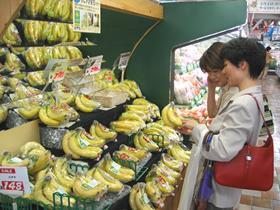
Household consumption of fresh fruit in Japan in February has fallen from 6.47kg to 5.82kg over the past 13 years, while purchasing prices reach a 13-year high during February at ¥434 (US$3.6) per kg, according to the latest data from the Ministry of Finance.
“While the price increase can usually be attributed to a tight supply, this is not the case,” Jack Moriya of importer Tokyo Seiko told Fruitnet. “The overriding factor is the weak demand and consumption in the Japanese market.”
A stagnant economy and weaker yen have been cited as causes for Japanese consumers’ conservative spending.
“The higher prices have meant a reduction in consumption, as Japanese consumers face a stagnant economy and wages, with heightened sensitivity to how they manage their disposable income, especially for luxury foods like fruits,” said Moriya.
Bad weather and disease have limited banana supplies have been pushing up prices, though Moriya is confident Japan’s banana market will stabilise as imports increase in coming months. Grapefruit in particular has seen a significant drop in consumption, down from 4.49kg per household in 2004 to 1.33kg in 2014.
“Grapefruit consumption remains stagnant, and continues on its gradual downward trend,” said Moriya. “With an ageing population, the number of Japanese with hypertension will increase, and grapefruit consumption will continue to be negatively impacted.”
The exception has been the kiwifruit market, with consumption relatively stable over the past 11 years, though as the domestic season wraps up and the New Zealand import season kicks off in April, Moriya said the weaker yen may yet affect imported kiwifruit sales.






No comments yet